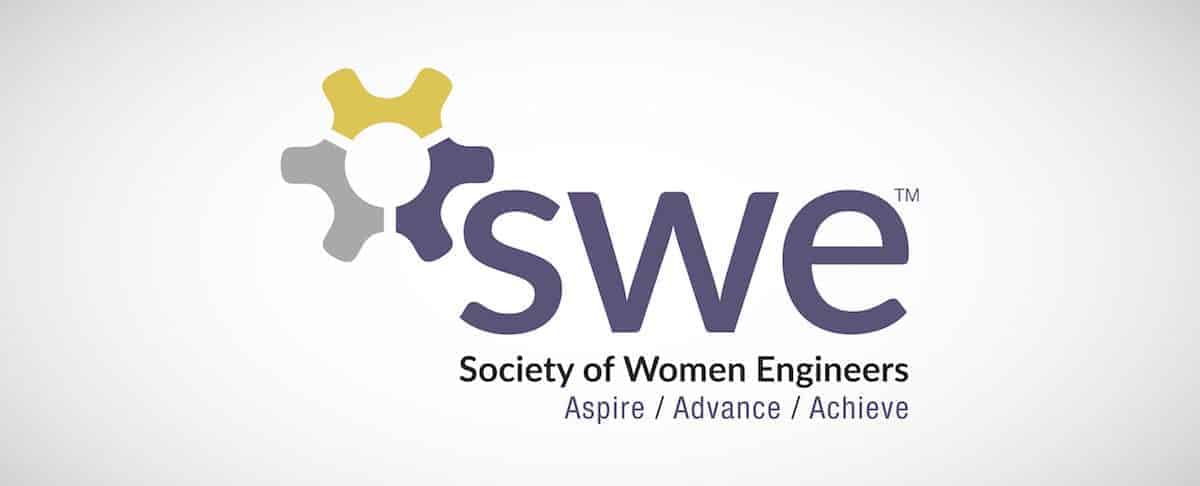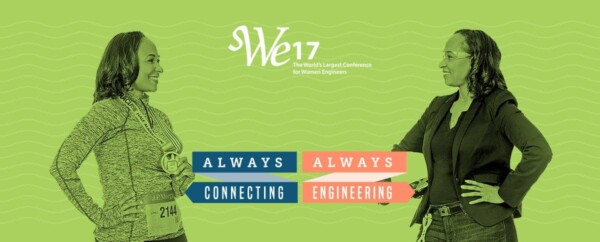Our Diverse podcast is brought to you by SWE Advance, supporting the recruitment, retention and advancement of women in engineering through career resources, professional development and one-to-one networking opportunities.
Jessica
Hi, I’m Jessica Rannow, FY17 President of the Society of Women Engineers and this is SWE’s Diverse podcast series. Please remember to add this podcast to your iTunes and like or follow us on social media. Visit swe.org for more details.
Joining me now is Natalie Vanderspiegel. Natalie is an FY17 Sonora Region Senator. She is a Professional Life Member of SWE. She has served as Section President, Vice President, Secretary, and Representative for the San Diego Professional Section. Her involvement in SWE extends with committee leadership roles at the Region and Society levels. Most recently, she served as the Chair for the Society’s Program Development Grant Committee. In 2015, she started her role as Senator for Region B in SWE.
Thanks for joining us Natalie. Tell us more about yourself and why you are a member of SWE.
Natalie
- Thank you Jessica. I am happy to join you today for this podcast. I joined SWE as a professional because I was looking to align myself and my volunteerism with a professional society that not only provided development opportunities for me but also gave back to my community. I was especially impressed by SWE’s mission to expand the image of the engineering profession as a positive force … and how this directly translated into the Pre-College Outreach Efforts that the Society and its members were conducting.
- As a child struggling with dyslexia, school wasn’t easy for me and I am extremely thankful to my engaged Science teachers in middle school that saw my potential and introduced me to the opportunities in STEM.
- With SWE, I have a forum to help other girls see that a career in STEM can be very rewarding and achievable for them.
Jessica
Natalie, as you know, SWE is undergoing a Governance Update. How have you been involved in that?
Natalie
- Last year, I began my term as Senator for the Society. Through informational interviews with current Senators and Society Board of Directors, I was aware that the Senate was planning to have a significant project on the future strategic direction for the Society on the docket for the year but I didn’t know the details. During the transition in Senate leadership over the summer of 2015, all of us – the Senators – were briefed on the efforts to date on the Governance Update and provided a copy of the report from McKinley. This was the start of my involvement with the effort.
- The report has 9 main sections: Board of Directors, Senate, Sections, Committees, Nomination Committee, Collegiates, HQ, International, and Regions. These sections became teams, what were called “Governance Working Groups”, with an additional team focused on Bylaws. And I was assigned to the Senate Working Group.
Jessica
The McKinley report is available on governance.swe.org under the detailed timeline and milestones. Tell us about the duties of the Senate Working Group.
Natalie
- For the bulk of last year, our working group meet to digest the recommendations from the McKinley group and determine, what I like to call “The Future State Senate,” would look like. I call it this because we have some ideas for what this group would be called but no decisions been made yet.
- We had meetings every other week and reviewed all of the current senate procedures through the lens of our vision for the Future State Senate. We challenged each other and our concepts of what the Senate has always done to really make sure we were putting together a plan for a body of Advisors that are chartered to lead the strategic direction of the Society.
- Before the Winter Senate Meeting in February, all of the Working Groups supplied a report to the Society Board of Directors. At that point, several of the groups expressed a concern for needing an additional level of detail on the overall structure of the Society … as several groups were doing parallel paths based on some key decisions on the structure. This is similar to having a plan A and plan B based on how a decision is made.
- Since the structure would dictate a lot of the key handoffs between the different working groups, the Winter Senate Meeting began with an update from Colleen, the Society President. This update included the 8,000 foot view that has been presented in several Webinars and presentations since. This 8,000 foot view allowed for a clearer vision for all the working groups to use as an assumption for their efforts and provided a much needed focus for the groups to continue.
- At the end of the Winter Senate Meeting, all of the working groups presented out on their progress and gave special attention to discussing the concerns and hand off points between working groups.
- The working groups continued to meet until the last BOD meeting for the year. At that point, we all created our final reports and the efforts have transitioned to the Governance Task Force.
Jessica
Can you give me an example of what you mean by “hand off points between working groups?
Natalie
- For the Senate Working Group, we had decided that we wanted to recommend that Nomination Committee assume responsibility for filling vacancies on the Board of Directors. We collaborated with the Nomination Committee Working Group so they could review the recommendation and provide feedback back to us.
- The hand offs and interactions also include the flow of communications … these are the arrows between the boxes on the 8,000 view.
Jessica
What is one of the recommendations from your Working Group that you think is important for that “Future State Senate” to be successful?
Natalie
- Wow, that is a hard question – there a lot of key recommendations.
- I would have to say the selection criteria of those that will sit on the Future State Senate is critical. Currently, the Senators are selected based on some basic qualifications and geographical boundaries. And what I mean by that is each Region has two professional Senators and one collegiate Senator.
- So … say your employer offers you a promotion that requires you to relocate to another region – if you move your membership to be a part of your new local section, you would no longer be eligible for your Senate role. I personally think that career mobility should not impact your ability to serve the Senate.
- This is especially meaningful to me because I have moved regions and being a part of the Senate is really important to me and I would be disappointed to have to forfeit my position.
- The recommendation for the Future State Senate would have a selection process that is based on a competency model in addition to basic qualifications. And the members would be elected by the entire Society membership along with a few being appointed.
- To me, this means our Senators will be selected because they have the right combination of skills and experiences rather than what zip code they live in.
Jessica
You mentioned the Governance Task Force, why did the effort move from the Working Groups to a Task Force?
Natalie
- Each Working Group was working on one piece of the pie at a very detailed and tactical level for the better part of a year. At the end of that year, it was time to understand those hand offs that I mentioned before. For instance, the Nomination Committee taking ownership of the task to fill vacancies … and how this interaction will work with all the others, together in the 8,000 foot view, that is where the Refresh is going to either be successful or not.
- The Task Force is now undertaking this difficult task of reviewing and combining the hundreds of recommendations from each of those Working Groups into one cohesive plan for the Society.
- Strategic work is tough, you have to challenge the norms and have a team that understands the tension this will create and can work professionally in that space … and let’s not forget the fact that they are doing this remotely. My working group had 18 members … Combining all the members from the 9 Working Groups would have been way too large of a group for a task like this. The Task Force is small and allows for this type of work to be successful. Also, since the Task Force needs to focus on these interactions – the members need to be more familiar with the overall current state and not just with one part … or slice of the pie … if I may continue with my metaphor.
Jessica
Are you pleased with the progress that we have made so far?
Natalie
- I will admit that in the weeks leading up to the Winter Senate Meeting, I felt like we were taking a long amount of time to make very little progress. Remember when I said that some of the working groups were doing parallel paths with path A and path B based on what way a decision was going to be made … that lack of a focused path was splitting up our resources.
- When the 8,000 foot view was given to all of the working groups, that was a huge milestone. It might seem like a small task to someone that wasn’t involved – but let me assure you, it wasn’t. It took a lot of work to translate the words that the McKinley advisors had given us into a model of an organization chart that worked for SWE … something that allowed us to maintain the strength of our grass-roots feel, or SWEster sisterhood … while providing us a structure that was flexible to the needs of our current membership and desired future growth.
- And I will also admit that as an engineer, I like to see Gantt charts with milestones laid out all nice and pretty; however, strategic work isn’t a design project – it has semi-fluid milestones at the start because you need to define where you are going before you will know how long it will take to get there.
- I appreciate that the Society has committed resources to allow us to do this right and take the time we need to thoroughly examine the recommendations from the external consultants and the individual working groups. I want to make sure we get this right … there is a lot riding on these decisions. I love SWE and I want SWE to be successful … our mission is just too important to jeopardize it by making a decision too quickly.
Jessica
What concerns have you heard from the membership on the Governance Update?
Natalie
- There is a lot of information on the governance website, including frequently asked questions that are submitted to the governance email address. I think a lot of people are concerned about how the communication will flow in the Society with the removal of regions. I also think there is a group of SWE Leaders and Future Leaders who are concerned about the leadership opportunities and growth without the regions and the positions the regions offer for leadership development.
Jessica
That brings up a good point, you said you joined SWE as a professional and one of the reasons was for your personal development – what are your thoughts on how the removal of the regions could impact our leadership opportunities.
Natalie
- Of course. I have a very personal connection to this question.
- When I moved Regions, I wasn’t eligible for some of the leadership roles in my new region because I had not already held committee roles within that region. But I knew I wanted to continue my leadership with the Society and find a way to give back for the mission. Knowing that, I joined the Society Program Development Grant Committee. In my first year, I volunteered to lead the pre-review team. For those not familiar with the Program Development Grant Committee, this was similar to leading a sub-group on any other committee. The following year, I moved into the role of Chair-Elect and then I was Chair. Two years later, I started my Senate role.
Jessica
So you went from Section Leadership to Committee Leadership to Society Leadership – correct?
Natalie
- Yes, that is correct and I never held a traditional Region Officer role.
Jessica
Do you feel that you were prepared to be a Senator without having had a Region Officer role?
Natalie
- Oh yes, I feel that my experiences prepared me very well for me role as Senator and that I was not at any disadvantage by not having a Region role.
- This is one of the models for the leadership pipeline in the 8,000 foot view – to go from Section Leadership to Committee Leadership to Society Leadership.
- Don’t get me wrong, traditional Region Leadership positions have provided value to our Society and have contributed to our growth. They have also been successful developmental paths for several of our past and current leaders.
- Regional Leadership is not the only path to Society Leadership … and it wasn’t my
Jessica
So why do you feel this Governance Update is important for our membership?
Natalie
- As a Society, we have grown so much – we have almost doubled in size in just the last 10 years! That is amazing and the credit goes to all of our members that share the mission of SWE and the value their membership has provided them.
- We work differently than we did 10 years ago; however, our structure hasn’t changed to reflect that. It is time to evolve and in order to do this, we need to refresh our governance structure.
- We need to make sure we have a structure that allows us to continue to grow without losing the that grass-roots feel that we know is at the core of SWE. That isn’t easy … so we have to get this right. We want our members to seek information about these changes and provide their feedback, concerns, and questions.
Jessica
Can you give me an example of one of the McKinley recommendations that you related to?
Natalie
- Yes, A common theme is that we often have leaders that serve in multiple roles at the same time.
- I can attest to this – I was the Chair of the Society PDG Committee the same year that I was the President of my local Section … oh yeah, and that year – our Region Conference was held in my city with our local Section as a co-hosts! Do I feel that I did a good job in my leadership roles – absolutely. Do I feel that I could have been more effective had I only had one role at a time – absolutely! And while that is hard to say, I don’t think this experience is unique to me. We have a history of spreading ourselves a bit too thin to cover all the important roles and important tasks. Often we see this turn into burnout … when a leader hits the “too much SWE wall” … or, in my case, we see that not every role is taken to maximum level because we are doing multiple roles at the same time.
- I feel that SWE is the type of organization that allows you to grow with it and it is important that our leaders are supported in their roles and set up to be successful in them.
Jessica
What are you looking forward to the most in regards to the Governance Update?
Natalie
- Another hard question … I would have to say that I am really looking forward to see how much more we are able to accomplish 10 years from now.
- Like … How many more young girls have we been able to introduce to STEM as a viable and rewarding career option?
- How many more members has SWE provided valuable leadership opportunities that have translated into demonstrating the skills required for their promotion at work?
- How many more diversity champions will we be able to reach?
- … the list is endless on what we will be able to accomplish!
Jessica
Any final thoughts Natalie?
Natalie
- Thank you Jessica … and I want to thank those that are listening to this podcast and reaching out to learn more about what Society is doing and our progress so far.
Jessica
To find out more about the Governance Update, go to governance.swe.org or email your questions to governance@swe.org.
Natalie Vanderspiegel is an FY17 Sonora Region Senator and Professional Life member of SWE. Natalie, thanks for participating in SWE’s Diverse podcast series.
Author
-
![Podcast: How SWE's Governance Update is Progressing [] SWE Blog](https://alltogether.swe.org/wp-content/uploads/2021/10/swe-favicon.png)
SWE Blog provides up-to-date information and news about the Society and how our members are making a difference every day. You’ll find stories about SWE members, engineering, technology, and other STEM-related topics.





